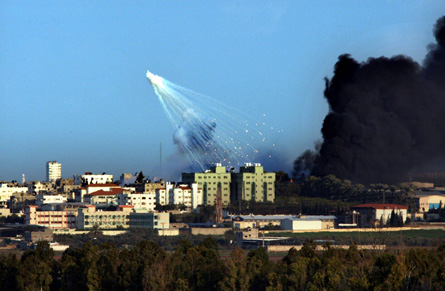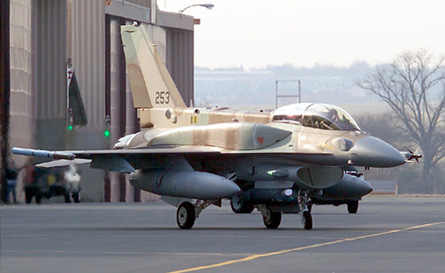Heavy air strikes performed by the Israeli air force on Hamas targets in the Gaza strip have again proved that air power has very defined limits when employed against a ground-based enemy.
Launched on 27 December, Israel's surprise attack - dubbed Operation "Cast Lead" - was based on an extensive "target bank" that had been compiled over several months using a variety of intelligence-gathering assets. The Israeli air force's unmanned air vehicles, which have been used extensively over Gaza in recent years, also played a major role by locating launchers used by Hamas personnel to fire home-made Kassam rockets and 122mm Grad rockets towards Israeli towns and cities up to 40km (22nm) away.
The amassed intelligence data gave not only the exact location of targets, but updated information about their construction, enabling the air force to adopt the best weapon system to achieve a "first hit, first kill" result.
Targets were attacked primarily using Lockheed Martin F-16s (F-16I pictured below) armed with a variety of precision weapons equipped with electro-optical, laser and GPS guidance units. Television footage from the combat area shows that in many cases 907kg (2,000lb) Mk 84 bombs were employed using Boeing Joint Direct Attack Munition and Rafael Spice guidance kits.
|
|
|---|
© Israeli air force |
The most striking example of the quality of the prepared target data came when in less than 4min, several F-16s destroyed a great number of tunnels that were being used to smuggle weapons from Egypt into the Gaza strip, the entrances to which were mostly concealed within buildings. Videos taken from sensors on different aerial platforms showed secondary underground explosions along the tunnels' paths when stored explosives detonated. Such instant battle damage assessment and real-time intelligence was in many cases gathered by UAVs.
Television coverage of the conflict has shown Israel Aerospace Industries Heron and Elbit Systems Hermes 450 tactical air vehicles flying over Gaza, while Palestinian sources have claimed that some Israeli UAVs have also used weapon systems to attack ground targets. These claims have not been confirmed by any official Israeli source.
 |
|---|
© Eliyahu Ben Yigal/Rex Features |
Pre-planned raids have formed only part of the operation, which had seen more than 1,000 combat sorties flown by 8 January. With Hamas personnel continuing to launch rockets, air force F-16s and Bell AH-1 Cobra and Boeing AH-64 Apache attack helicopters (AH-64D pictured, below) have also been widely used in a round-the-clock hunt for launch teams. Demand for UAV, helicopter and fighter cover also rose after Israeli ground forces entered the Gaza strip on 3 January, effectively splitting the territory in two.
 |
|---|
© Israeli air force magazine |
Footage released by the Israel Defence Force on 6 January showed ground forces receiving instant close air support, mainly from combat helicopters. This was made possible by a number of systems that allow even small infantry units to communicate directly with available aircraft to request rapid fire against a target to for example suppress snipers or address heavy mortar fire.
The relatively high level of mortar fire produced by Hamas units has called for many "hover and kill" missions, where attack helicopters circle above the combat area at high altitude before dropping to low level to engage their targets. Apaches have been filmed using weapons including Lockheed AGM-114 Hellfire air-to-surface missiles during the conflict.
Combat helicopters involved in the campaign have used flares in every mission, due to information which indicates that Hamas has acquired a limited number of shoulder-launched surface-to-air missiles.
As evidenced during close air support missions and earlier air strikes, data fusion has been highly important in supporting the success of the Israeli raids, and in minimising "sensor-to-shooter" times. Combined control centres receive online inputs from airborne and ground sensors that are instantly overlaid on existing human intelligence, enabling the air force to track and destroy moving targets, such as trucks used to transport rockets from hiding places to launch sites, and to hunt for Hamas leadership targets.
Former Israeli air force commander Maj Gen (Ret) Eitan Ben-Eliahu says the air operation over Gaza has been characterised by very accurate intelligence, excellent command and control and co-ordination between the air force, ground forces and the Israeli navy. "This is a textbook operation if we look at the number of aerial attacks combined very closely with infantry and naval forces," he says.
However, after almost two weeks of activity and with attacks continuing to be made on launch sites, Hamas rockets continue to be fired into Israeli territory in great numbers.
Ben-Eliahu says collateral damage considerations are a limiting factor when F-16s and attack helicopters have a clear target in what is one of the world's most densely populated areas. "The air raids have succeeded in decreasing the number of rocket launches, but they cannot eliminate them," he concludes.
Israel has, however, faced widespread international condemnation for the scale of its intervention in Gaza. Its latest operation follows a four-week air campaign mounted against Hezbollah militants in southern Lebanon during 2006, which failed to halt rocket attacks on Israel despite totalling more than 4,500 offensive sorties.
Source: Flight International

















